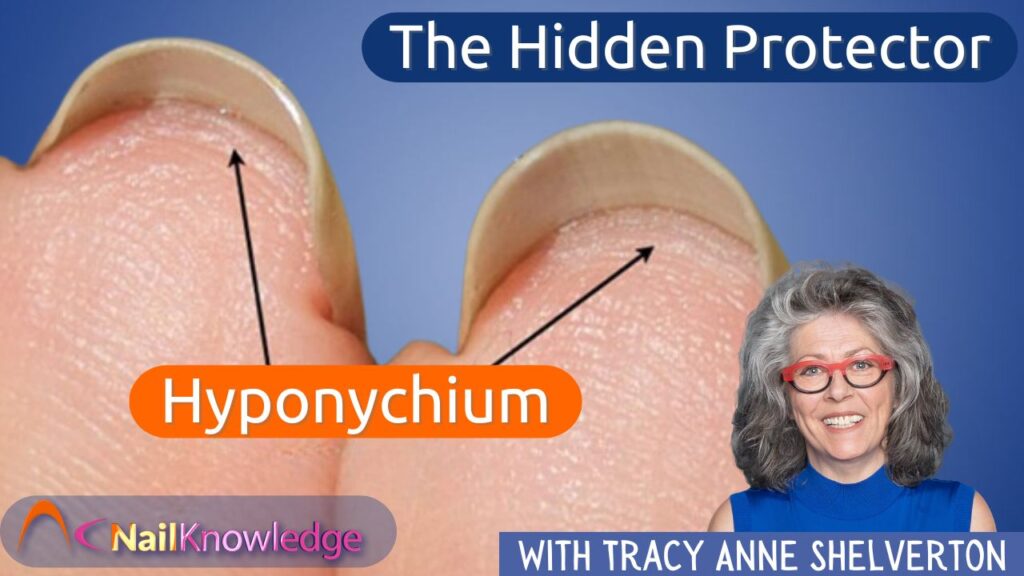The Hidden Protector
As a nail professional, you know the importance of keeping nails looking flawless, but how often do we really talk about the hyponychium? It might not be the most glamorous part of the nail, but it’s one of the most crucial. If you’ve been overlooking it, now’s the time to change that. Let’s investigate why the hyponychium deserves your attention and how understanding it can elevate your nail care skills to a whole new level.
What Exactly Is the Hyponychium?
The hyponychium is the area of skin right under the free edge of the nail plate—the part of the nail that extends past the fingertip. Think of it as the gatekeeper of the nail unit, forming a seal that keeps harmful bacteria, pathogens, and allergens out. It might look small and simple, but it plays a big role in keeping the sensitive areas of the nail bed and matrix protected. Neglecting this area could leave your clients vulnerable to infections or other nail issues, which brings us to our next point.
Why Should Nail Techs Care About the Hyponychium?
As nail professionals, your clients rely on you to not only make their nails look great but also to keep them healthy. The hyponychium is packed with nerve endings—sort of like a security system for the nail. If this protective seal is broken, those nerve endings kick into gear, alerting the body with discomfort or pain. This should be your first clue that something isn’t right. A compromised hyponychium can open the door for bacteria, fungal infections, and even onycholysis (when the nail plate starts separating from the nail bed).
In short: a healthy hyponychium means happy, healthy nails. And that means happy clients.
Signs the Hyponychium Needs Attention
As a nail tech, knowing the signs of hyponychium issues can prevent bigger problems down the line. Here are a few things to look out for:
- Thickening or Discoloration: If the hyponychium starts to thicken or change color, it could be a sign of an infection. If a fungal infection is suspected, test to know for sure and treat accordingly.
- Pain or Discomfort: Your client mentions sensitivity or pain around the free edge—this could indicate that the seal has been compromised.
- Onycholysis: If you notice the nail lifting from the nail bed, that’s a major red flag. This condition often stems from a damaged hyponychium and can lead to a more serious infection if not addressed.
The Impact of Hyponychium on Nail Health
If the hyponychium is compromised, it doesn’t just affect the appearance of the nails—it can cause real health concerns for your client. Infections can develop, and untreated issues can even lead to long-term damage to the nail matrix. You don’t want that for your clients, and they don’t want to deal with it either.
So how do you protect this important area? Gentle handling of the nails is key. Over-filing the free edge or using tools too aggressively can damage the hyponychium. Also, make sure to encourage your clients to avoid bad habits like nail-picking, which can break the seal and invite infection.
Good Nail Hygiene is your Best Defense.
Here’s what you can do as a nail professional to maintain a strong and healthy hyponychium for your clients:
- Gentle Filing: When shaping nails, avoid over-filing near the free edge to protect the hyponychium.
- Clean but Careful: Keep the nail area clean, but avoid poking or pushing too hard on the hyponychium.
- Watch for Signs of Infection: Always be on the lookout for discoloration, thickening, or signs of discomfort.
- Educate Clients: Teach your clients about the importance of the hyponychium and proper nail care routines to keep this area intact.
- Nail Unit Maintenance: When applying oil, do so at the back side of the free edge, this way the oil first soaks around the hyponychium before it makes its way along the lateral nail folds to the PNF.
Final Thoughts: Don’t Overlook the Hyponychium
As a nail professional, your expertise goes beyond just aesthetics—your job is to protect the health of your clients’ nails. The hyponychium may be hidden, but it plays a critical role in nail health. By giving this small but mighty structure the attention it deserves, you’re ensuring your clients not only walk away with beautiful nails but with nails that are strong and healthy from the inside out.
So, next time you’re prepping a client’s nails, take a moment to think about the hyponychium.
It’s not just another part of the nail—it’s the silent protector that makes all the difference.


